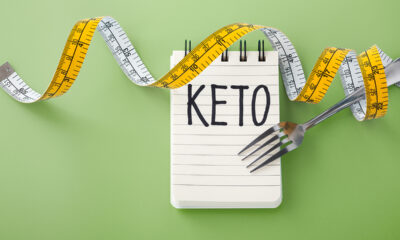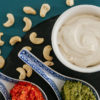Nutrition
Are You Getting Enough Protein?
Protein is an important part of a balanced diet. Whether your goal is to get stronger, gain muscle, lose fat, or generally improve your fitness, protein consumption is one factor that can be monitored to help meet your goals! Let’s dive in.
What is Protein?
Protein is one of the macronutrients needed for our bodies to function, along with carbohydrates and fats. As someone who lifts weights, focusing on proper protein intake can help you maximize the hard work you are doing under the barbell.
While fats and carbohydrates function as a source of energy, protein is more of a structural and functional macronutrient. It helps form structures in the body and facilitates many bodily functions. Although it is possible for protein to be used for energy, this only occurs when there is excess protein in the die, or when there is not enough carbohydrate to support normal energy production (as a last resort!).
All proteins are composed of amino acids which are typically categorized into two groups: essential and nonessential. Essential amino acids are needed in the body but need to be consumed through diet, whereas nonessential amino acids are created within the body and do not (typically) need to be consumed in the diet.
When a food contains all of the essential amino acids in correct quantities, it is known as a complete protein. In general, animal proteins, such as meat, are complete proteins while plant proteins are considered incomplete proteins since they do not contain all of the essential amino acids. Certain dietary patterns (such as veganism) limit consumption of animal products so it is important for individuals who do not consume complete proteins to ensure they are consuming the correct quantities of essential amino acids.
The amino acid leucine is a key factor for increasing muscle protein synthesis to facilitate muscle recovery and growth. Leucine is the only amino acid that has demonstrated the ability to independently enhance muscle building [1]. Foods high in leucine include ground beef, chicken breast, whole eggs, whey and casein protein powders, fish, and milk. When it comes to plant-based diets, foods higher in leucine include seeds (such as pumpkin, flax, hemp), soybeans, and lentils.
Protein Intake and Resistance Training
Dietary protein is particularly important for Buff Chicks (and anyone who participates in resistance training as a form of exercise!). Appropriate protein ingestion helps to maximize muscle protein synthesis (MPS), which allows the body to build muscle in response to exercise [2]. Muscle growth is optimized when the rate of MPS is enough to counteract muscle protein breakdown (MPB), and exceed MPB over time [2-4].
This process starts when proteins are consumed, protein-rich foods must first be broken down into amino acids so that protein synthesis can join the amino acids together to form proteins such as lean tissues, like muscle.
Individuals who participate in resistance training stimulate MPS and MPB on an ongoing basis. When lifting weights, the fibers in muscles are constantly being broken down (MPB), and repaired (MPS) in an effort to increase muscular hypertrophy, muscle strength, and other performance- or physique-related goals.
Protein Intake Recommendations
In general, individuals need between 0.8 to 2.2 grams of protein per kilogram of bodyweight (~0.5-1.0 g/lb) per day [5]. People who are sedentary require less protein than people who are active. And, those exercising for longer durations or higher intensities will require more protein than those exercising with shorter durations and lesser intensity. Additionally, more protein is required to recover from strength training than from cardiovascular training [8].
For those who participate in light to moderate levels of resistance training, 1.5 to 2.0 grams of protein per kilogram of body weight (~0.7-0.9g/lb) is recommended [6, 8]. For those who participate in moderate to vigorous levels of resistance training, 1.7 to 2.2 grams of protein per kilogram of body weight (0.8-1.0g/lb) is recommended [6,8].
The recommendation of 0.8 grams of protein per kilogram body weight (0.4g/lb) is a daily minimum need that may be as high as 1.2 grams of protein per kilogram of body weight (0.5g/lb) based on new evidence [5, 6]. Consuming up to 2.2 grams of protein per kilogram of body weight (~1g/lb) is an acceptable goal, even for people who are sedentary [6].
In regard to supplementing protein, it appears that total protein consumption (independent of the source) is the most important factor. However, if supplementing protein helps you achieve your protein goals, it could be beneficial [7].
Fact or Fiction: The Anabolic Window
Many studies have observed increased rates of MPS when consuming protein 1 to 2 hours after resistance training; however, only a few studies have found that muscle gain is enhanced over time when protein is consumed post-workout and total daily protein intake is controlled [12].
Science Spotlight: A recent meta-analysis of 53 total studies (20 studies for muscle growth and 23 studies for muscle strength) found no statistically significant effect of post-workout protein consumption when total daily protein intake is equal [12].
Does the Timing of Protein Intake Matter?
The most important factor with protein intake is the amount you can consume across an entire day. If you have a good handle on daily protein intake, more customization around protein timing and strategies could be used. There are some minor improvements that can be observed long-term from strategic timing of protein ingestion throughout the day [9-11].
Generally, pre-workout and intra-workout protein consumption are probably not that important if you ate a meal 1-2 hours before training [11].
Science Spotlight: A study comparing the rates of MPS found that four servings of 20 grams of whey protein was superior to the timing strategies of two servings of 40 grams of whey protein and eight servings of 10 grams of whey protein equally spaced over the 12-hour period [13].
3 Tips for Optimizing Protein Consumption
So far, we have covered what protein is, why it is important, and how much you need. Let’s finish up with some tangible strategies to help you reach your protein goals.
Tip #1: Plan Ahead
Planning your meals ahead will help you more easily meet your protein goals. One way to make this easier is to identify foods that are higher in protein. You can estimate your protein needs based on the recommendations listed earlier in the article.
Tip #2: Distribute Protein Throughout The Day
In conjunction with planning ahead, planning meals/snacks high in protein throughout the day is ideal. The findings from a research study that examined optimal protein timing suggests that every meal should contain at least 0.4 grams of protein per kilogram of body weight and at least four meals should be consumed throughout the day.
Example: If you weigh 63kg, and eat 4 meals per day, each meal should contain at least ~25g (63kg x 0.4g) of protein. Note: this is an estimate and could be higher based on your individual goals and activity level.
Tip #3: Supplement
While supplementing protein isn’t required to meet your goals, it can certainly help get your daily protein intake up! Try a supplement such as Buff Chicks Supplements’ Buff Whey – a 100% Whey Protein Isolate. Not only is the product a high quality protein, but It iit’s third party tested so that it embraces the gold standard in testing protocols. A product like this carries the Banned Substance Control Group (BSCG) stamp of approval – Certified Drug Free. With decades of experience in anti- doping and sport drug testing as a foundation, BSCG offers the Olympic standard in analytical testing to finished product brands, ingredient suppliers, manufacturing facilities, teams, leagues, athletes, and other consumers that want to verify that the quality of products and ingredients meet expectations. This critical information helps ensure ingredients are not contaminated with drugs or other agents that can lead to health concerns or positive drug tests. BSCG certifications demonstrate that brands have gone above and beyond industry standards to assure athletes and consumers that products have been made right. The BSCG stamp is on premium brands that go the extra mile for product quality offering you the best possible outcomes for your purchase. The BSCG stamp is the way to make supplement shopping easier for yourself.
Key Takeaways
- Individuals who resistance train have higher protein needs than sedentary individuals.
- 24-hour protein consumption should be the primary concern but some minor additional benefits can be seen with strategic protein timing before, during, and after exercise.
- To optimize protein intake, space out at least 4 balanced meals with 20-30g of protein every ~3 hours.
- Consuming a protein supplement, such as Buff Whey, is one way to ensure overall protein intake.
By Dr. Brittany Masteller
About the Author
Dr. Brittany Masteller holds her Bachelor’s, Master’s and PhD degrees in Health and Exercise Science. She works as a Research Scientist for Orangetheory Fitness. Dr. Britt owns a fitness coaching and consulting business with the mission of helping bridge the gap between exercise science and public health. She is also a fitness enthusiast with a passion for exercise and competing in bodybuilding and Strongman.
References
Norton, L. E., & Layman, D. K. (2006). Leucine regulates translation initiation of protein synthesis in skeletal muscle after exercise. Journal of Nutrition, 136(2), 533S–537S.
Stokes T, Hector AJ, Morton RW, McGlory C, Phillips SM. Recent Perspectives Regarding the Role of Dietary Protein for the Promotion of Muscle Hypertrophy with Resistance Exercise Training. Nutrients. 2018 Feb 7;10(2):180. doi: 10.3390/nu10020180. PMID: 29414855; PMCID: PMC5852756.
Atherton PJ, Smith K. Muscle protein synthesis in response to nutrition and exercise. J Physiol. 2012;590(5):1049-1057. doi:10.1113/jphysiol.2011.225003
Phillips S.M., Tipton K.D., Aarsland A., Wolf S.E., Wolfe R.R. Mixed muscle protein synthesis and breakdown after resistance exercise in humans. Am. J. Physiol. 1997;273:E99–E107. doi: 10.1152/ajpendo.1997.273.1.E99.
Trumbo, P., Schlicker, S., Yates, A. A., Poos, M., Food and Nutrition Board of the Institute of Medicine, & The National Academies. (2002, Nov.). Dietary reference intakes for energy, carbohydrate, fiber, fat, fatty acids, cholesterol, protein and amino acids. Journal of the American Dietetic Association, 102(11), 1621–1630.
Norton, L. E., & Wilson, G. J. (2009). Optimal protein intake to maximize muscle protein synthesis. AgroFood Industry Hi-Tech, 20, 54–57.
Pasiakos SM, McLellan TM, Lieberman HR. The effects of protein supplements on muscle mass, strength, and aerobic and anaerobic power in healthy adults: a systematic review. Sports Med. 2015 Jan;45(1):111-31. doi: 10.1007/s40279-014-0242-2. PMID: 25169440.
Pencharz, P. B., Elango, R., & Wolfe, R. R. (2016). Recent developments in understanding protein needs – How much and what kind should we eat? Applied Physiology, Nutrition, and Metabolism, 41(5), 577–580. doi:10.1139/apnm-2015-0549.
Mori, H. (2014). Effect of timing of protein and carbohydrate intake after resistance exercise on nitrogen balance in trained and untrained young men. Journal of Physiological Anthropology, 33, 24. doi:10.1186/1880-6805-33-24.
Mamerow, M. M., Mettler, J. A., English, K. L., Casperson, S. L., Arentson-Lantz, E., Sheffield-Moore, M., Paddon-Jones, D. (2014). Dietary protein distribution positively influences 24-h muscle protein synthesis in healthy adults–3. Journal of Nutrition, 144(6), 876–880.
Kerksick CM, Arent S, Schoenfeld BJ, et al. International society of sports nutrition position stand: nutrient timing. J Int Soc Sports Nutr. 2017;14:33. Published 2017 Aug 29. doi:10.1186/s12970-017-0189-4.
Schoenfeld, B.J., Aragon, A.A. & Krieger, J.W. The effect of protein timing on muscle strength and hypertrophy: a meta-analysis. J Int Soc Sports Nutr 10, 53 (2013). https://doi.org/10.1186/1550-2783-10-53
Schoenfeld BJ, Aragon AA. How much protein can the body use in a single meal for muscle-building? Implications for daily protein distribution. J Int Soc Sports Nutr. 2018;15:10. Published 2018 Feb 27. doi:10.1186/s12970-018-0215-1.
Photo by Tyler Nix on Unsplash.














